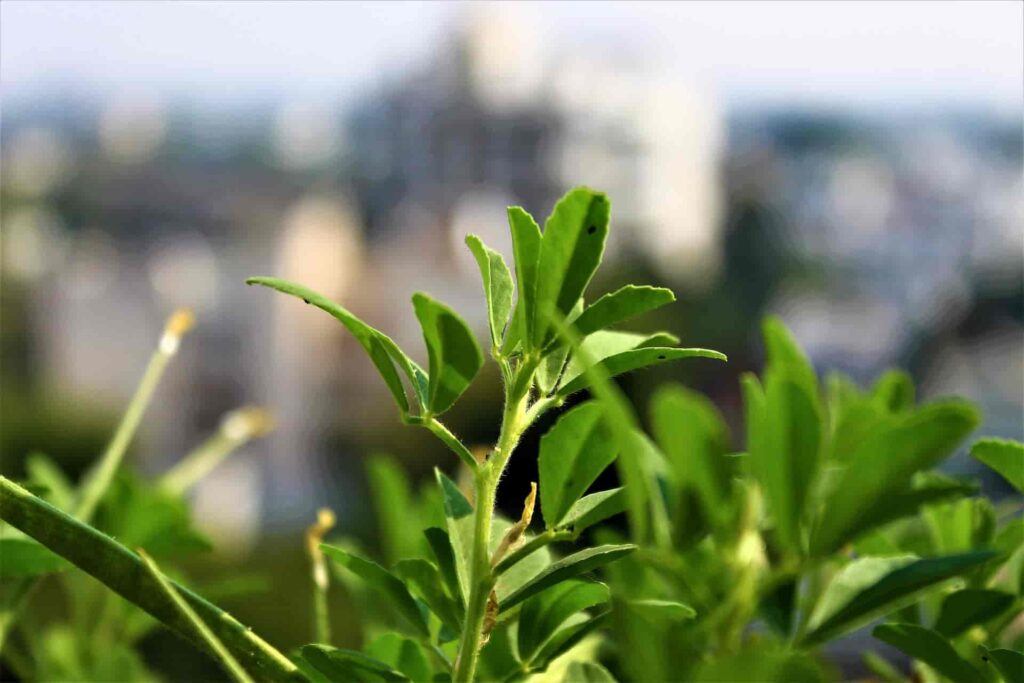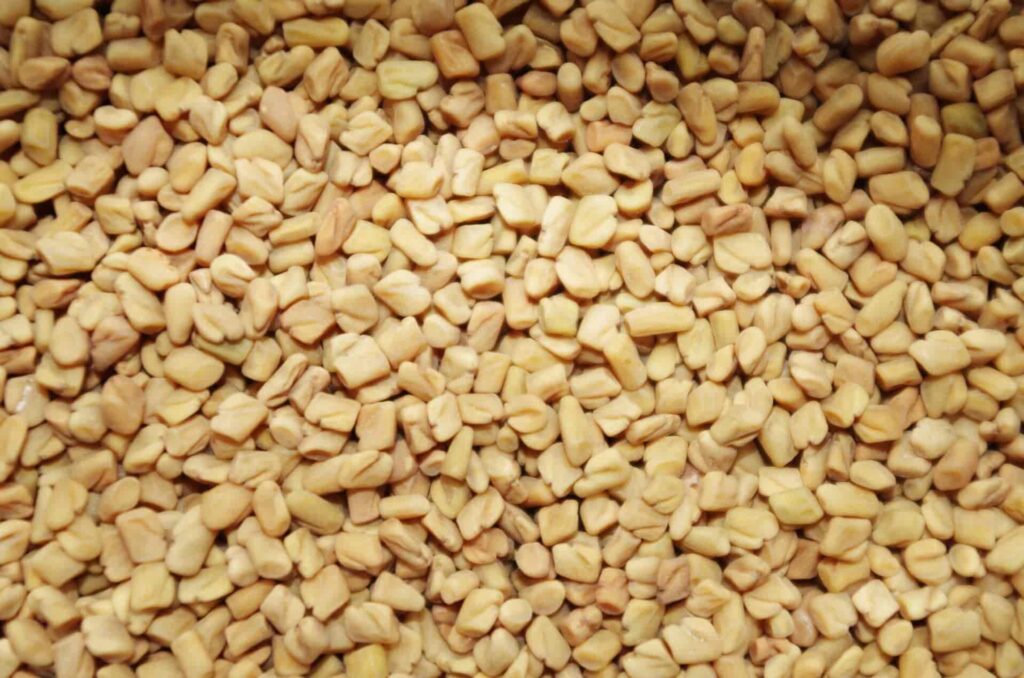Methi Plant is known as Fenugreek Plant (Trigonella Foenum-Graecum) in English. It is a popular herb across the world due to its multifold uses both as a medicinal plant and its use as a green leafy vegetable. Fenugreek seeds or Methi Seeds (also called Methi Dana) are known to possess anti-bacterial and anti-fungal properties. It belongs to the legume family.
Methi Plant belongs to the plant family Fabaceae. It is an annual plant (meaning it completes its lifecycle in a single growing season and then dies). Methi seeds (Fenugreek seeds) and Methi leaves (Fenugreek leaves) are used as an ingredient in many dishes from the Indian subcontinent. Fenugreek is also used in traditional medicines.
India is one of the major producers of Fenugreek and Fenugreek Seeds in the world. Methi finds its use as a herb, spice, and vegetable in various cuisines.
Fenugreek seeds are used in powdered form and in whole form as a spice in Indian cuisines.
Now that you know multiple benefits of the Methi Plant, why not grow them at home? Read this article to know more about growing fenugreek plants at home, uses of fenugreek and fenugreek seeds, their benefits, etc.
Contents
How To Grow Methi Plant?

Methi Plant is a beautifully aromatic herb and a great addition to your kitchen garden or herb garden due to its medicinal value, great soil building characteristics. It is an easy to grow annual plant and a must-have herb in your garden.
Methi plant is grown from seeds. These plants do not like to be transplanted. Hence sow the seeds directly in a pot from which you would want to finally harvest.
Container / Pot Selection
The roots of Methi Leaves are shallow and do not require a lot of soil in depth. In fact, a pot with a large depth is not suitable as the soil will hold a lot of water which is not good for this plant at fenugreek plant does not like waterlogged soil.
Choose a wide shallow pot for growing Methi Leaves.
Optimum Temperature to Grow Fenugreek Plant
Methi Plant requires a warm and humid environment to grow. They do not tolerate frost. The fenugreek seeds should be sown only after the frost has passed preferably during the spring up till late summer.
If you want to harvest fenugreek seeds, start growing the plant in early summer or spring so that the plant gets sufficient time to mature the flowers and able to produce seeds.
The optimum temperature to grow fenugreek leaves is 10°C (50°F) to 33°C (90°F). They grow well in USDA hardiness zones from 9-11.
In India, best time to sow the seeds is during the end of summer season -September to November.
Sunlight Requirement
Methi Plant needs 4-5 hours of direct sun for optimum growth. However, the leaves will wilt in extreme summer conditions like that of tropical countries of the Indian subcontinent. They can grow in partial shade too but a minimum of 2-3 hours of sunlight is a must.
If you live in colder countries, plant them outdoors in a sunny spot.
Potting Mix/ Soil Requirements of Methi Plant
The seeds should be planted in rows about 7-8 inches apart. Sow the seeds about 1/2 or 1/4 inch deep into the soil.
You can use normal garden soil with some quantity of organic manure. The soil should not be too clayey as the fenugreek plant does not like waterlogged soil. The soil however should be moist all the time.
Methi plants can grow in just any type of well-drained soil. However, the optimum growth occurs in soil with a neutral or slightly alkaline pH. A pH of 6.4 to 8.1 is good for this plant.
For a detailed pictorial understanding of how to grow the plant, read this article.
Fertilizing Fenugreek Plant
Methi leaves do not require a lot of fertilizer application to grow. One can use organic compost like cow dung cakes, neem cakes, or vermicompost in the soil to prepare the garden soil.
You can also apply used tea leaves as a fertilizer.
Height of Methi Plant
Fenugreek leaves plant can grow up to a height of 2 feet. The leaflets normally have 3 ovate green leaves.
Fenugreek Plant Flower

Methi Plant produces white, yellow, and purple flowers growing from leaf axils. Methi seeds develop in the curved yellow pods.
Pinching of Fenugreek Plant
Keep pruning or pinching 33% of the top of the stem of the plant regularly to encourage lush and fuller growth. It will also prevent seed formation.
However, if you are growing the plant for fenugreek seeds, avoid pinching and let the plant grow to its full length until it starts producing mature flowers and develops seed pods.
How To Grow Methi in Water (Without Soil)?
Methi can be grown in water without any soil. Method of growing fenugreek without soil is as follow:
- Soak 1/2 cup fenugreek seeds in water for about an hour.
- Drain the water and keep the seeds in a covered bowl.
- Rinse the seeds daily with fresh water to avoid the development of any mold.
- Seeds will start germination in about 3-4 days.
- Once germination starts spread the seeds on a tray. Spray the tray with water mist once a day or when you feel the tray is getting dry.
- Cover the tray with a wet cloth/tower or plastic to create a moist humid environment inside the tray. Do not keep the tray in direct sunlight as it will destroy the sprouts.
- Once the leaves are about 4.5 inches long, you can harvest the baby leaves.
How Long Does It Take To Grow Methi / Fenugreek?
Methi Plant is one of the quickest herbs to grow at home.
Seed germination takes place in 3 to 4 days. Methi leaves fully mature in about 3-4 weeks from the date of sowing the seeds after which they can be harvested.
If you have grown fenugreek plant for seeds, then the plant will produce seeds after 3-5 months of planting.
They are also used as microgreens in which case you can harvest the plants in 8-10 days from the time of sowing the seeds.
Diseases & Pests in Methi Plant
Fenugreek plants are rarely infected by pests or plant diseases. A few pests that can infect the plant are aphids, powdery mildew, charcoal rot, etc.
In case you find any pests, you can use a neem oil spray to treat the plant (I recommend using organic fertilizers only on fenugreek leaves as the leaves are directly used in the preparation of food).
Mix neem 5-6 ml of neem oil concentrate and 2-3 drops of liquid soap in 1 liter of water in a spray bottle. Shake the solution and spray on your plants every alternate day for a week.
Uses of Methi Plant / Fenugreek Plant
Extract of fenugreek is used in many day-to-day products like:
- Cosmetics
- Garam masala
- Soaps
- Tea
- Condiments
- Maple syrup, etc.
Benefits of Methi Plant/ Fenugreek Plant
Parts of fenugreek plants have many uses described in the sections below. When grown alongside other plants in your garden, they help to fix nitrogen in the soil thereby increasing the fertility and quality of the soil.
Fenugreek plant quickly covers the ground when grown with other plants helping in keeping the weeds away from your garden. It produces nutrients in the soil and helps in regulating the moisture of the soil.
Benefits of Methi Seeds / Fenugreek Seeds / Methi Dana

- Fenugreek seeds are considered to be a natural herbal medicine to treat people with diabetes.
- Fenugreek powder is used as a dressing for skin wounds or eczema.
- Methi seeds are used to feed fish and domestic rabbits.
- Methi seeds are used as a flavoring agent in many dishes.
- They are believed to help with diabetes.
Methi Leaves Benefits
- Fenugreek leaves are used to prepare a number of cuisines across the world.
- Methi leaves are used as animal fodder.
- They are considered a herbal medicine in many traditions.
- Methi leaves are believed to help in increasing breast milk production in lactating mothers.
- They are helpful in reducing menstrual pain and cramps.
- They are believed to improve bone health and reduce the risk of certain estrogen-dependent cancers. However, the effects are not clinically established.
- Methi leaves are rich in dietary fiber. Hence it acts as a good digestive agent.
- Fenugreek leaves are a good source of calcium and iron.
Methi Water Benefits
Methi Water/ Fenugreek Water is believed to have many health benefits. Some of them include following:
- It facilitates weight loss.
- Methi water is beneficial for the liver, kidneys, and metabolism.
- It is considered good to consume when you have common-cold.
- Fenugreek water is considered good for lactating mothers as it is believed to help produce more breast milk.
- It generates heat in the body.
- It is good for your immunity.
- Fenugreek seeds water is believed to help in hair growth. It helps in fighting dandruff and roughness of hair.
- Helps in flushing out harmful toxins from the body.
- Helps in flushing out kidney stones.
- Methi seeds water acts as an antacid.
Methi Leaves Recipes
Methi plant is used in many Indian recipes in the form of leaves, seeds, powdered seeds etc.
It is often prepared with potato to make “Aaloo Methi” which is a popular Indian dish.
Another popular dishes include “Methi Paratha“, “Methi Thepla“, “Methi Daal” and many more.
“Kasuri Methi” is another variety of fenugreek known for its aroma and used in the form of dried leaves in many dishes to add its distinguishing flavor.
It is also used in Turkish cuisine, Iranian cuisine, Georgian cuisine, Egyptian cuisine, Eritrean cuisine, Ethiopian cuisine, etc.
If you have any query or comment, please leave a reply in the comment section below.
If you like this article, please share with your family and friends.
If you would like to read more interesting articles, please read the following posts:
- Raat Ki Rani / Night Blooming Jasmine – Plant Care Tips and Grow Guide
- String of Pearls Plant: Complete Plant Care Guide
- Crepe Jasmine / Chandni Flower Plant: Plant Guide






Leave a Reply